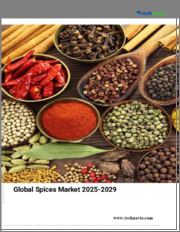
|
시장보고서
상품코드
1677982
세계의 혼합 향신료 시장 규모, 점유율, 성장 분석 : 유형별, 용도별, 유통 채널별, 지역별 - 산업 예측(2025-2032년)Blended Spices Market Size, Share, and Growth Analysis, By Type (Garam Masala, Berbere), By Application (Food and Beverages, Bakery and Confectionery), By Distribution Channel, By Region - Industry Forecast 2025-2032 |
||||||
혼합 향신료 시장 규모는 2023년 188억 5,000만 달러로 평가되었습니다. 또한, 2024년 199억 6,000만 달러에서 2032년에는 315억 8,000만 달러로 성장하고, 예측 기간(2025-2032년) 동안 5.9%의 연평균 복합 성장률(CAGR)을 보일 것으로 예측됩니다.
세계 혼합 향신료 시장은 이국적이고 에스닉한 맛에 대한 소비자의 관심 증가로 인해 강력한 성장세를 보이고 있습니다. 간편식의 확산과 함께 바로 사용할 수 있는 향신료 블렌드에 대한 수요가 급증하고 있으며, 항산화 및 항염증 효과가 있다는 인식으로 인해 유기농 및 건강 지향적 제품에 대한 관심이 높아지고 있습니다. 주요 시장 동향으로는 퓨전 요리와 잘 알려지지 않은 독특한 향신료 조합의 인기를 들 수 있습니다. 그러나 고급 블렌드의 높은 비용, 위조품, 원재료 가격 변동 등의 문제도 여전히 남아 있습니다. 기회는 블렌드 커스터마이징, 베이커리 및 제과류에 향신료의 통합, 아시아태평양 및 중동 시장 확대에 있습니다. 또한, 온라인 유통의 부상은 시장 성장을 더욱 촉진할 것입니다.
목차
서론
- 조사 목적
- 조사 범위
- 정의
조사 방법
- 정보 조달
- 2차와 1차 데이터 방법
- 시장 규모 예측
- 시장 전제조건과 제한
주요 요약
- 세계 시장 전망
- 공급과 수요 동향 분석
- 부문별 기회 분석
시장 역학과 전망
- 시장 개요
- 시장 규모
- 시장 역학
- 성장 촉진요인과 기회
- 성장 억제요인과 과제
- Porter의 Five Forces 분석
주요 시장 인사이트
- 중요 성공 요인
- 경쟁 정도
- 주요 투자 기회
- 시장 생태계
- 시장의 매력 지수(2024년)
- PESTEL 분석
- 거시경제 지표
- 밸류체인 분석
- 가격 분석
- 사례 연구
- 고객과 구매 기준 분석
혼합 향신료 시장 규모 : 유형별&CAGR(2025-2032년)
- 시장 개요
- Garam Masala
- Berbere
- Chinese Five Spice
- Shichimi Togarashi
- 기타
혼합 향신료 시장 규모 : 용도별&CAGR(2025-2032년)
- 시장 개요
- 식품 및 음료
- 빵 및 제과
- 스낵
- 레디밀
- 기타
혼합 향신료 시장 규모 : 유통 채널별&CAGR(2025-2032년)
- 시장 개요
- 기업
- B2C
- 온라인 소매
- 슈퍼마켓 및 하이퍼마켓
- 전문점
혼합 향신료 시장 규모 : 지역별&CAGR(2025-2032년)
- 북미
- 미국
- 캐나다
- 유럽
- 독일
- 스페인
- 프랑스
- 영국
- 이탈리아
- 기타 유럽
- 아시아태평양
- 중국
- 인도
- 일본
- 한국
- 기타 아시아태평양
- 라틴아메리카
- 브라질
- 기타 라틴아메리카
- 중동 및 아프리카
- GCC 국가
- 남아프리카공화국
- 기타 중동 및 아프리카
경쟁 정보
- 주요 5개사 비교
- 주요 기업의 시장 포지셔닝(2024년)
- 주요 시장 기업이 채택한 전략
- 최근 시장 동향
- 기업의 시장 점유율 분석(2024년)
- 주요 기업 개요
- 기업 상세
- 제품 포트폴리오 분석
- 기업 부문별 점유율 분석
- 매출 전년대비 비교(2022-2024년)
주요 기업 개요
- McCormick & Company, Inc.(USA)
- Ajinomoto Co., Inc.(Japan)
- Everest Spices(India)
- Olam International(Singapore)
- Unilever(UK/Netherlands)
- MDH Spices(India)
- Associated British Foods plc(UK)
- Worlee Gruppe GmbH(Germany)
- Kerry Group plc(Ireland)
- Fuchs Gruppe(Germany)
- Badia Spices Inc.(USA)
- Frontier Co-op(USA)
- Baria Pepper(Vietnam)
- Synthite Industries Ltd.(India)
- SHS Group(UK)
- DS Group(India)
- Goya Foods, Inc.(USA)
- The Kraft Heinz Company(USA)
결론과 제안
LSH 25.04.21Blended Spices Market size was valued at USD 18.85 billion in 2023 and is poised to grow from USD 19.96 billion in 2024 to USD 31.58 billion by 2032, growing at a CAGR of 5.9% during the forecast period (2025-2032).
The global blended spices market is witnessing robust growth, driven by rising consumer interest in exotic and ethnic flavors. As convenience foods gain traction, demand for ready-to-use spice blends is surging, with an increasing focus on organic and health-oriented products, fueled by awareness of their antioxidant and anti-inflammatory benefits. Key market trends include the popularity of fusion cuisines and unique, lesser-known spice combinations. However, challenges persist, such as high costs for premium blends, counterfeit products, and fluctuating raw material prices. Opportunities lie in the customization of blends, the integration of spices into bakery and confectionery items, and expanding markets in the Asia Pacific and Middle East. Additionally, the rise of online distribution is set to further enhance market growth.
Top-down and bottom-up approaches were used to estimate and validate the size of the Blended Spices market and to estimate the size of various other dependent submarkets. The research methodology used to estimate the market size includes the following details: The key players in the market were identified through secondary research, and their market shares in the respective regions were determined through primary and secondary research. This entire procedure includes the study of the annual and financial reports of the top market players and extensive interviews for key insights from industry leaders such as CEOs, VPs, directors, and marketing executives. All percentage shares split, and breakdowns were determined using secondary sources and verified through Primary sources. All possible parameters that affect the markets covered in this research study have been accounted for, viewed in extensive detail, verified through primary research, and analyzed to get the final quantitative and qualitative data.
Blended Spices Market Segments Analysis
Global Blended Spices Market is segmented by Type, Application, Distribution Channel and region. Based on Type, the market is segmented into Garam Masala, Berbere, Chinese Five Spice, Shichimi Togarashi and Others. Based on Application, the market is segmented into Food and Beverages, Bakery and Confectionery, Snacks, Ready Meals and Others. Based on Distribution Channel, the market is segmented into B2B, B2C, Online Retail, Supermarkets and Hypermarkets and Specialty Stores. Based on region, the market is segmented into North America, Europe, Asia Pacific, Latin America and Middle East & Africa.
Driver of the Blended Spices Market
The Blended Spices market is being significantly driven by the rising interest in ethnic and international cuisines, as consumers increasingly seek out specific spices and blends associated with these culinary traditions. For example, the growing fondness for Indian cuisine has fueled a heightened demand for essential spices like garam masala and curry powder. In parallel, the allure of Mexican dishes has also contributed to a greater demand for spice blends such as chili powder and taco seasoning. This trend reflects a broader shift towards diverse flavor profiles and authentic cooking experiences, ultimately shaping consumer preferences in the spice market.
Restraints in the Blended Spices Market
The blended spices market faces significant challenges due to the unpredictable fluctuations in raw material prices, including essential ingredients like peppers and cinnamon. Various factors, including adverse weather conditions and geopolitical tensions, contribute to this volatility, creating a climate of uncertainty for manufacturers. Such unpredictability can result in inconsistent production costs, making it difficult for companies to maintain stable pricing and manage their profit margins effectively. Consequently, these fluctuations can hinder growth and stability within the blended spices market, affecting the ability of manufacturers to plan for future demand and investment opportunities.
Market Trends of the Blended Spices Market
The blended spices market is witnessing a significant trend towards sustainable and ethical sourcing, driven by consumers' growing awareness of the environmental and social implications of their purchasing decisions. This shift is prompting manufacturers to adopt responsible sourcing practices, including the procurement of Fairtrade-certified spices and supporting local suppliers to reduce carbon footprints. As transparency and sustainability become core values, brands emphasize their commitment to ethical practices in marketing and packaging. This trend is likely to influence product development, with an increasing demand for organic and responsibly sourced spice blends, ultimately reshaping the industry's landscape and catering to the conscientious consumer.
Table of Contents
Introduction
- Objectives of the Study
- Scope of the Report
- Definitions
Research Methodology
- Information Procurement
- Secondary & Primary Data Methods
- Market Size Estimation
- Market Assumptions & Limitations
Executive Summary
- Global Market Outlook
- Supply & Demand Trend Analysis
- Segmental Opportunity Analysis
Market Dynamics & Outlook
- Market Overview
- Market Size
- Market Dynamics
- Drivers & Opportunities
- Restraints & Challenges
- Porters Analysis
- Competitive rivalry
- Threat of substitute
- Bargaining power of buyers
- Threat of new entrants
- Bargaining power of suppliers
Key Market Insights
- Key Success Factors
- Degree of Competition
- Top Investment Pockets
- Market Ecosystem
- Market Attractiveness Index, 2024
- PESTEL Analysis
- Macro-Economic Indicators
- Value Chain Analysis
- Pricing Analysis
- Case Studies
- Customer & Buying Criteria Analysis
Global Blended Spices Market Size by Type & CAGR (2025-2032)
- Market Overview
- Garam Masala
- Berbere
- Chinese Five Spice
- Shichimi Togarashi
- Others
Global Blended Spices Market Size by Application & CAGR (2025-2032)
- Market Overview
- Food and Beverages
- Bakery and Confectionery
- Snacks
- Ready Meals
- Others
Global Blended Spices Market Size by Distribution Channel & CAGR (2025-2032)
- Market Overview
- B2B
- B2C
- Online Retail
- Supermarkets and Hypermarkets
- Specialty Stores
Global Blended Spices Market Size & CAGR (2025-2032)
- North America (Type, Application, Distribution Channel)
- US
- Canada
- Europe (Type, Application, Distribution Channel)
- Germany
- Spain
- France
- UK
- Italy
- Rest of Europe
- Asia Pacific (Type, Application, Distribution Channel)
- China
- India
- Japan
- South Korea
- Rest of Asia-Pacific
- Latin America (Type, Application, Distribution Channel)
- Brazil
- Rest of Latin America
- Middle East & Africa (Type, Application, Distribution Channel)
- GCC Countries
- South Africa
- Rest of Middle East & Africa
Competitive Intelligence
- Top 5 Player Comparison
- Market Positioning of Key Players, 2024
- Strategies Adopted by Key Market Players
- Recent Developments in the Market
- Company Market Share Analysis, 2024
- Company Profiles of All Key Players
- Company Details
- Product Portfolio Analysis
- Company's Segmental Share Analysis
- Revenue Y-O-Y Comparison (2022-2024)
Key Company Profiles
- McCormick & Company, Inc. (USA)
- Company Overview
- Business Segment Overview
- Financial Updates
- Key Developments
- Ajinomoto Co., Inc. (Japan)
- Company Overview
- Business Segment Overview
- Financial Updates
- Key Developments
- Everest Spices (India)
- Company Overview
- Business Segment Overview
- Financial Updates
- Key Developments
- Olam International (Singapore)
- Company Overview
- Business Segment Overview
- Financial Updates
- Key Developments
- Unilever (UK/Netherlands)
- Company Overview
- Business Segment Overview
- Financial Updates
- Key Developments
- MDH Spices (India)
- Company Overview
- Business Segment Overview
- Financial Updates
- Key Developments
- Associated British Foods plc (UK)
- Company Overview
- Business Segment Overview
- Financial Updates
- Key Developments
- Worlee Gruppe GmbH (Germany)
- Company Overview
- Business Segment Overview
- Financial Updates
- Key Developments
- Kerry Group plc (Ireland)
- Company Overview
- Business Segment Overview
- Financial Updates
- Key Developments
- Fuchs Gruppe (Germany)
- Company Overview
- Business Segment Overview
- Financial Updates
- Key Developments
- Badia Spices Inc. (USA)
- Company Overview
- Business Segment Overview
- Financial Updates
- Key Developments
- Frontier Co-op (USA)
- Company Overview
- Business Segment Overview
- Financial Updates
- Key Developments
- Baria Pepper (Vietnam)
- Company Overview
- Business Segment Overview
- Financial Updates
- Key Developments
- Synthite Industries Ltd. (India)
- Company Overview
- Business Segment Overview
- Financial Updates
- Key Developments
- SHS Group (UK)
- Company Overview
- Business Segment Overview
- Financial Updates
- Key Developments
- DS Group (India)
- Company Overview
- Business Segment Overview
- Financial Updates
- Key Developments
- Goya Foods, Inc. (USA)
- Company Overview
- Business Segment Overview
- Financial Updates
- Key Developments
- The Kraft Heinz Company (USA)
- Company Overview
- Business Segment Overview
- Financial Updates
- Key Developments



















